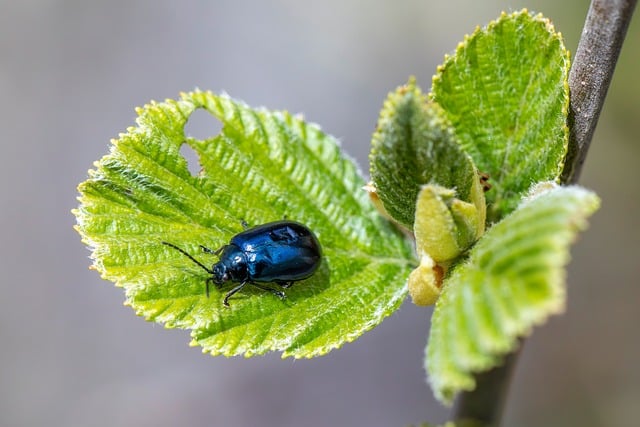Understanding and addressing attractants like nectar sources, protein-rich foods, and sweet substances is key for effective commercial stinging pest removal. This involves regular cleaning, proper waste management, landscaping maintenance, ventilation in food areas, and thorough inspections. Sealing entry points with weatherstripping or mesh screens, implementing robust prevention strategies including eco-friendly repellents, clear employee communication, and professional services are essential. After treatment, proper post-care like regular cleaning, clutter removal, and gap repairs prevent future infestations, ensuring a safe, comfortable commercial environment.
Stinging pests like bees, wasps, and hornets can pose significant risks in commercial spaces, causing property damage and posing health hazards. Understanding common attractants is key to prevention. This comprehensive guide offers expert advice on reducing stinging pest attractants in commercial settings. From identifying risk factors to implementing effective strategies and professional treatment options, we provide proven solutions for lasting protection, ensuring a safer environment for your business. Discover the best practices for commercial stinging pest removal.
Understanding Common Stinging Pest Attractants in Commercial Spaces
In commercial spaces, understanding common stinging pest attractants is key for effective commercial stinging pest removal. Bees, wasps, and yellow jackets are often drawn to areas with abundant nectar sources, such as flowers, fruit trees, and compost piles. These pests are also attracted to protein-rich foods and sweet substances left behind by employees or customers, making food preparation areas, trash bins, and outdoor seating popular hangouts.
Identifying these attractants is the first step in a proactive pest management strategy. Commercial spaces should implement regular cleaning routines, properly seal waste bins, and maintain landscaping to minimize flower nectar availability. Additionally, ensuring proper ventilation in food service areas can deter pests from seeking out protein-rich meals. Regular inspections and prompt cleanup of spills or crumbs can significantly reduce the likelihood of attracting stinging pests, creating a safer and more comfortable environment for both employees and customers.
Implementing Effective Prevention Strategies for Stinging Pests
Implementing effective prevention strategies is key to reducing stinging pest attractants, especially in commercial settings where managing these issues is crucial for both employee safety and customer comfort. Start by identifying potential entry points for pests like bees, wasps, or hornets—common stinging pests. Seal any gaps or cracks in windows, doors, and walls using weatherstripping, caulk, or mesh screens. Regularly inspect and maintain exhaust fans and vents to prevent insects from entering through these openings.
Consider implementing a comprehensive pest management program that includes regular inspections, proper waste disposal, and the use of non-toxic, eco-friendly repellents. For commercial stinging pest removal, professional services can offer tailored solutions such as traps, baits, or biological controls. Regular communication with employees about maintaining clean work areas, promptly cleaning up spills, and reporting any pest activity is also vital in preventing these pests from establishing a presence on the premises.
Professional Treatment Options for Commercial Stinging Pest Removal
When dealing with a stinging pest infestation in commercial spaces, professional treatment is often the best course of action. Experienced pest control experts offer specialized knowledge and access to advanced equipment that can effectively target and eliminate these pesky intruders. One common approach involves the application of industrial-strength insecticides, carefully tailored to the specific species causing the disturbance. These chemicals are applied by professionals who understand safety protocols, ensuring minimal risk to employees and customers while maximizing their impact on the pests.
Additionally, professionals employ a range of other strategies like exclusion methods, where they identify and seal entry points to prevent future infestations. Traps and monitoring systems are also set up to capture and track pest activity, providing valuable data for targeted treatment. This comprehensive approach ensures not just immediate relief from stinging pests but also long-term prevention, making it ideal for maintaining a safe and comfortable commercial environment.
Post-Treatment Care and Maintenance Tips for Long-Lasting Results
After a professional commercial stinging pest removal service, proper post-treatment care and maintenance are essential to ensure long-lasting results. Regular cleaning and inspection routines should be established to remove any remaining pest debris or eggs. This includes thoroughly sweeping and mopping floors, especially in areas with high foot traffic, and vacuuming carpets and upholstery to capture any hidden remnants.
Additionally, maintaining a clean and clutter-free environment is crucial. Pests are attracted to food sources and hiding spots, so keeping spaces tidy and eliminating potential nesting sites will deter future infestations. Regularly inspect and repair any gaps or cracks in walls, doors, and windows, as these entry points can be addressed during the initial treatment and through ongoing maintenance to keep pests at bay.
Stinging pest control in commercial spaces requires a multi-faceted approach, from understanding attractants to implementing prevention strategies and considering professional treatments. By combining these methods, businesses can effectively manage and reduce the presence of stinging pests, ensuring a safer and more comfortable environment for employees and customers alike. Remember, proactive measures and regular maintenance are key to achieving and maintaining commercial stinging pest removal success.
